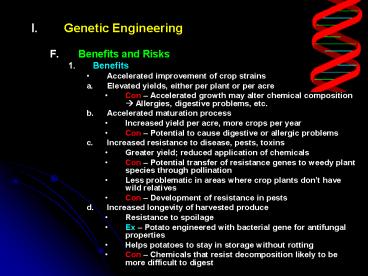Genetic Engineering - PowerPoint PPT Presentation
1 / 10
Title: Genetic Engineering
1
- Genetic Engineering
- Benefits and Risks
- Benefits
- Accelerated improvement of crop strains
- Elevated yields, either per plant or per acre
- Con Accelerated growth may alter chemical
composition ? Allergies, digestive problems, etc. - Accelerated maturation process
- Increased yield per acre, more crops per year
- Con Potential to cause digestive or allergic
problems - Increased resistance to disease, pests, toxins
- Greater yield reduced application of chemicals
- Con Potential transfer of resistance genes to
weedy plant species through pollination - Less problematic in areas where crop plants dont
have wild relatives - Con Development of resistance in pests
- Increased longevity of harvested produce
- Resistance to spoilage
- Ex Potato engineered with bacterial gene for
antifungal properties - Helps potatoes to stay in storage without rotting
2
- Genetic Engineering
- Benefits and Risks
- Benefits
- Increased resistance to disease, pests, toxins
- Reduced losses ? Greater yield
- Reduced application of chemicals
- Con Potential transfer of resistance genes to
weedy plant species through pollination - Less problematic in areas where crop plants dont
have wild relatives - Con Development of resistance in pests
- Increased longevity of harvested produce
- Resistance to spoilage
- Ex Potato engineered with bacterial gene for
antifungal properties - Helps potatoes to stay in storage without rotting
- Con Chemicals that resist decomposition likely
to be more difficult to digest
3
- Genetic Engineering
- Benefits and Risks
- Benefits
- Increased resistance to cultural extremes
- Ex Insertion of Arctic flounder antifreeze
protein genes into strawberry - Confers greater frost resistance and better fruit
storage properties - Con Potential transfer of antifreeze genes to
weedy plant species - Increased nutritional value
- Ex High starch potato that absorbs less oil
when cooking (low fat potato chips) - Ex Canola oil (Laurical) with healthier
composition - Con Unknown effects of eating modified foods
- Ex Insertion of Brazil nut gene into soybeans
to increase protein content - Many people allergic to Brazil nuts
4
- Genetic Engineering
- Benefits and Risks
- Benefits
- Reduced dependence on chemical fertilizers
- American farmers spend gt12 billion a year on
chemical fertilizers - 50 or more of fertilizer applied to crops is not
absorbed and enters runoff ? water pollution - Insert genes from plants that carry out nitrogen
fixation - Con Transfer of nitrogen fixation to weeds
could be disastrous
5
- Genetic Engineering
- Benefits and Risks
- Risks
- Unexpected effects
- May or may not be beneficial
- Ex Klebsiella planticola (soil bacterium)
engineered to transform plant residue into ethyl
alcohol (fuel) - GM strain in soils produced EtOH, leading to
poisoning of grasses and decrease in populations
of beneficial mycorrhizal fungi - Ex Pseudomonas putida (bacterium) engineered to
degrade 2,4-D (herbicide) - Breakdown products highly toxic to fungi,
including mycorrhizae - Ex Bacillus thuringiensis (Bt) toxin may bind
to soil particles, slowing degradation and
maintaining toxicity for longer than expected
6
- Solid Wastes
- Prior to 1900, most waste disposal involved
burying waste in ground - Perception of garbage dumps as breeding grounds
for disease ? incinerators - Burning garbage common until more stringent
emissions standards in 1970s - Incineration replaced by newer landfills
- Landfills
- Decreasing in number
- 7924 in 1988 vs. 1754 in 2007
- Becoming larger
- Total capacity didnt change between 1988 2002
- Becoming increasingly full
- Possible sources of toxic chemical leaching into
ground water - Increasingly difficult to find new sites (NIMBY)
7
Source EPA
8
Source EPA
9
(No Transcript)
10
(No Transcript)































